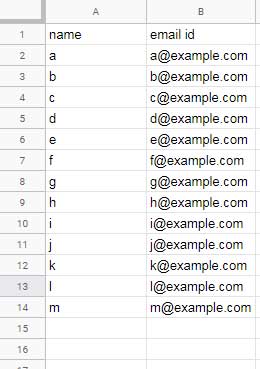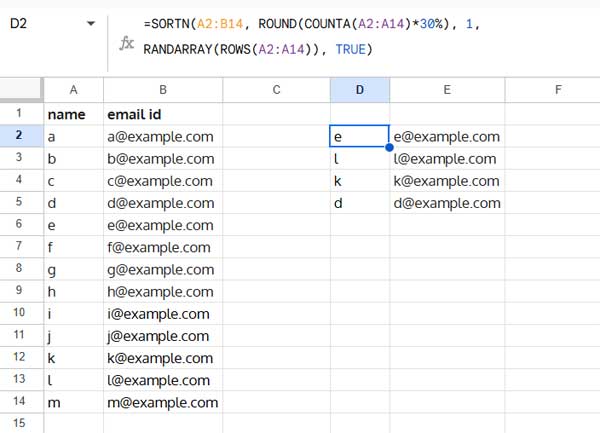You may need to extract a certain percentage of data from a large dataset for analysis. Rather than extracting from the first, last, or any specific portion, it’s better to randomly extract a certain percentage of rows, such as 20% or 50%. You can easily achieve this using a formula in Google Sheets.
Formula to Extract N% of Rows in Google Sheets
=SORTN(data, ROUND(COUNTA(col)*50%), 0, RANDARRAY(ROWS(col)), TRUE)When using this formula for proportional random sampling, make the following adjustments:
- Replace
datawith the data range. - Replace
colwith the reference of any column in the dataset. - Replace
50%with the percentage of data you want to randomly extract.
Example: Randomly Extract a Certain Percentage of Rows in Google Sheets
Consider the following dataset with names in column A and email addresses in column B.

Extracting ‘N’ Percentage of Rows
To extract 30% of the data from this range, use the formula as follows:
=SORTN(A2:B14, ROUND(COUNTA(A2:A14)*30%), 0, RANDARRAY(ROWS(A2:A14)), TRUE)The dataset contains 13 rows. 30% of 13 is 3.9. Since row numbers must be whole numbers, the formula rounds up and returns 4 random rows.

Additional Step: Convert to Static Data
The formula refreshes whenever the sheet changes or at specific intervals due to the use of the RANDARRAY function, which is volatile.
If you want static data, copy the result and apply Paste Special as follows:
- Assume the result is in D2:E5.
- Select D2:E5.
- Right-click and select Copy.
- Right-click again and select Paste special > Values only.
How the Formula Extracts N% of Rows
The formula uses the SORTN function, which returns n rows after sorting.
nis determined dynamically by:ROUND(COUNTA(A2:A14)*30%)
This calculates the number of rows to extract based on the given percentage.- The data is sorted using:
RANDARRAY(ROWS(A2:A14))
This generates random numbers corresponding to the height of the dataset, effectively shuffling the data.
That’s the logic behind randomly extracting a certain percentage of rows for random sampling in Google Sheets.





















